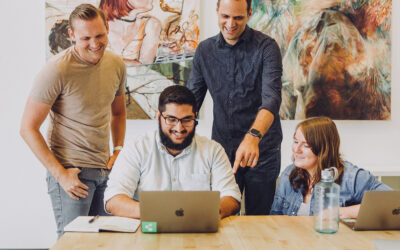2020 was the year the world ‘broke’ – and 2021 is, for a number of reasons, the year that we put it back together. But, as with the best renovations, the fixes are a mix of returning to what was and adding in new and better. There’s an opportunity here to create a new paradigm that lifts the most positive of what we’ve experienced over the last 10 months and weaves it into a new reality for us all.
Throughout 2020, we’ve focused on ‘climate’ – the short term emotional responses and urgent needs that people have experienced as we, incredibly, went from a world where many businesses were 90% plus office based, to one that was the polar opposite. The rapid ‘climate’ fixes are necessary, but they are short-term and we need to shift gears.
Climate, over time, will force changes upon the culture. Think of it like the sand and the waves. The latter is the climate – changing tempo, energy and impact based on external factors. The beach is the culture – it’s more fixed, but over time will shift. Stormy seas will reshape a beach – occasionally in extreme ways, such as the [beach in Ireland](https://www.theguardian.com/world/2017/may/08/irish-beach-washed-away-reappears-freak-tide#:~:text=Irish beach washed away 33 years ago reappears overnight after freak tide,-This article is&text=An Irish beach that disappeared,only rocks and rock pools.) that re appeared overnight, having been absent for 33 years. Although, normally, culture takes longer to change and climate is about what people are thinking, feeling and doing right now, they both work in identical ways, influence each other, and can equally face disruptive forces.
A great example of these two factors at play is present in a conversation I was having with a client last week about how the small elements of their culture were missing whilst they were operating in such a remote world, which was having a real impact on how people were feeling. They had hit a target and would normally have pizza and celebrate in the office (these types of behaviours, delivered consistently, are significant in the creation of culture). I suggested that we look at our CIA model (which explores what we Control, Influence, what we have to Accept). We came up with the fact that what she could do to create a moment of celebration is get a pizza delivered to each member of the team and ask the local delivery companies to write a message with a sharpie on the box. Then, have a zoom pizza celebration. It’s within our Control and little moments like this keep the long-term culture alive by creating the right immediate climate, even if a variation on the desired way of celebrating.
Culture is not purely formed through responses to situations, (well, not formed properly – you’ll get a culture, just not the one that you wanted). The work now is to start being proactive and forward-thinking. A future pattern is emerging. No one is in any doubt about a vaccine, and this offers a solution to many of the pandemic problems. For far too long we’ve managed and led people in a short-term holding pattern – the ‘fog’ of the future being too dense to actually flight-path a way through.
The fog is lifting, and, to keep people focused, on track and engaged, we need to talk about a plan. Organisations that don’t will suffer badly, as their people rail against the ‘denial’ of what has changed and what the new future could be. ‘Uncertainty’ is becoming ‘possibility’ and capitalising on this will be critical. What will be needed is a balancing act between responding to the short-term ‘climate’ needs – the peaks and troughs, the waves and the harder graft of re-shaping the ‘beach’ for a long-term future. Constantly asking yourself and your people ‘what’s the art of the possible’ is going to be a powerful driver and focus for minds.
So, fast forward six-nine months and imagine the most positive future. The vast majority of your workforce are able to safely travel, meet and commute. But they don’t want to. Why should they? We’ve just spent 18 months proving it’s not needed, so slipping back to ‘the same old, same old’ wont work. We also don’t know the future of the virus, and how we deal with it alongside the vaccine.
So do we do nothing? Nope, we do lots. We start planning WITH the rest of the organisation. We have the conversations and propose futures that respond to emergent possibilities and the out-there ‘how abouts?’. We’re working with a large Education Group at the moment and this week we were talking with the exec team about how they can end the term with team conversations about ‘what have we learned in 2020’ and ‘what do we want to intentionally take into 2021 and beyond’ – conversations that would span the way we work, behave and value each other as well as their students. With another senior group this week, we helped them to reflect on what has been successful this year in helping them accelerate parts of their strategy, looked at their plan for the next five years and then took each element to see what had been accelerated as a by-product of the reality, and what had really ground to a halt.
Eight months ago we drew a diagram of ‘change and retraction’ – looking at which organisations would shrink and possibly disappear because of the pandemic, and which ones were (or could be) innovating and changing to both survive and thrive. How is our prediction doing? It’s a little too early to tell, given the props that various governments have provided to shore up business. However, when we see British Airways resorting to selling the crockery from its retired Jumbos, we may be on to something.
This is (business) evolution, sped up dramatically. The most adaptable survive change, as they flex from one state and one situation to another. The ones that don’t? They are the ones that have a narrow niche, and cannot survive out of it. Survival is being a rat… not a panda.



